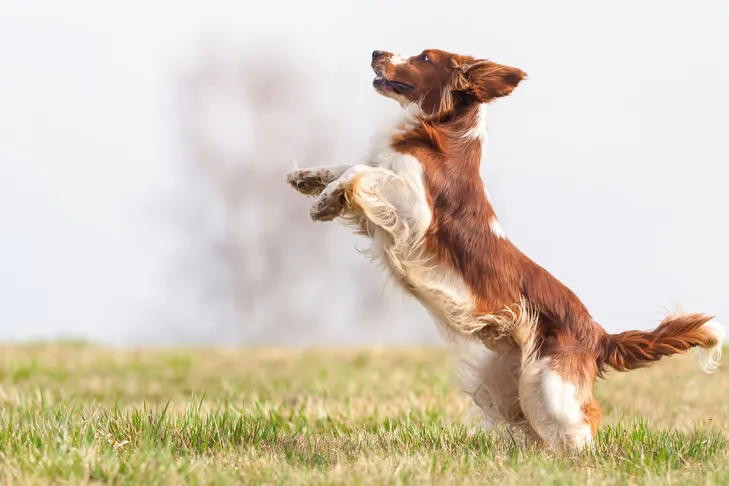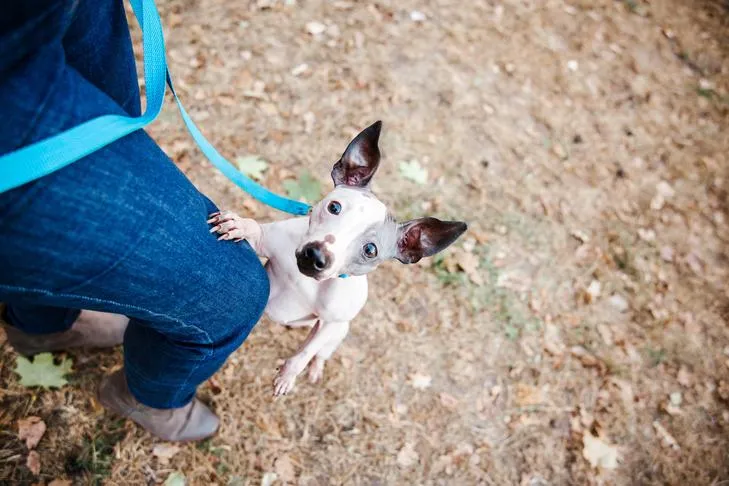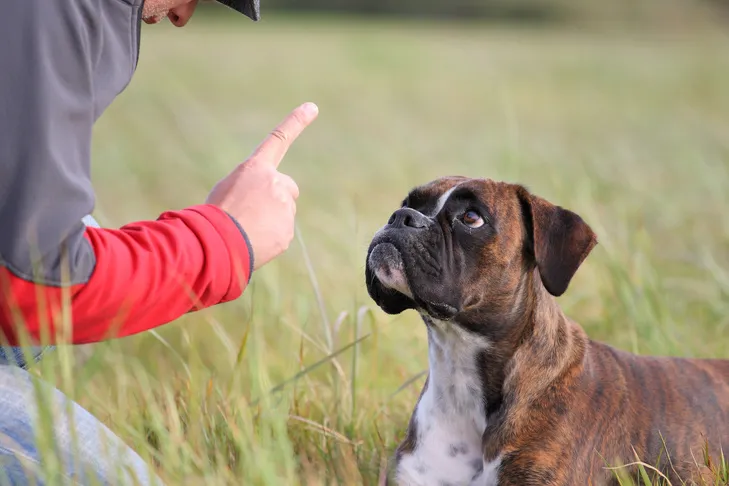Jumping up is a common yet often frustrating behavior for dog owners. While your dog might simply be trying to greet you face-to-face or grab your attention, their enthusiastic leaps can be annoying, messy, and even dangerous, especially for children or seniors who could be knocked over. Even smaller breeds can leave scratches or muddy paw prints on your clothes. The good news is, you can teach your dog an alternative, more polite way to say “hello.” This guide from Dog Care Story will show you How To Get My Dog To Stop Jumping On Me and instead adopt appropriate greeting manners, transforming those boisterous welcomes into calm, four-ppaws-on-the-floor interactions.
Our goal is to teach your dog a new greeting rule, like “keep your front paws on the floor” or “sit for greetings,” providing a safer and more courteous way for them to express their excitement. Consistency and positive reinforcement are key to helping your canine companion understand what to do, rather than just what not to do. With these proven strategies, you’ll soon have a dog that knows exactly how to welcome you and others politely. For those dealing with younger pups, learning how to prevent puppy from jumping up early can make a significant difference.
1. Only Greet Your Dog When They Have Four Paws on the Floor
The most effective way to address unwanted behaviors is to teach your dog an incompatible alternative. Instead of focusing solely on “no jumping,” guide them towards what you do want them to do. For example, if your rule is “four paws on the floor,” your dog physically cannot jump and stand simultaneously. You might also choose to teach them to sit or lie down during greetings. Whatever rule you establish, only provide attention and affection when your dog is following it. Consistency is paramount: if you allow jumping when you’re in casual clothes but not in formal wear, your dog will be confused and progress will be slow. Make the rule clear and unwavering.
2. Give Attention Immediately When All Paws Are on the Floor
Dogs tend to repeat behaviors that result in a desired outcome. Since your attention is a powerful reward for your dog, it’s crucial to provide it as soon as they adhere to your greeting rule. The moment your dog’s front feet touch the floor after an attempted jump, or if they greet you with all four paws on the ground, immediately offer praise and gentle petting. Don’t delay your greeting by fumbling with your keys or removing your coat; your dog might become impatient and try other attention-seeking behaviors. Promptly rewarding the desired action helps your dog connect their “four on the floor” behavior with the positive reinforcement of your attention.
3. Remove Attention When Your Dog Jumps
Conversely, to extinguish jumping behavior, you must stop rewarding it entirely. If your dog jumps on you, immediately remove the attention they are seeking. This can be as simple as calmly turning your back, stepping away, or even leaving the room for a few seconds. This teaches your dog that jumping achieves the opposite of what they want. As soon as your dog’s paws are back on the floor, turn back and quietly praise them. This clear on/off signal helps your dog understand that their behavior dictates whether they receive your attention or not, which is a crucial step to get a dog to stop jumping on me.
 Energetic Welsh Springer Spaniel playfully jumping on owner, highlighting a common challenge when teaching a dog to stop jumping on people.
Energetic Welsh Springer Spaniel playfully jumping on owner, highlighting a common challenge when teaching a dog to stop jumping on people.
4. Set Up Your Dog for Success with Proactive Strategies
While ignoring jumping and rewarding proper greetings is effective, it can be a trial-and-error process for your dog. You can accelerate their learning by proactively setting them up for success. If your rule is to sit for greetings, ask them to sit as soon as you enter the door. If “four on the floor” is your preference, encourage them to stay standing calmly.
A highly effective method to prevent jumping is to scatter tasty treats on the floor as you walk in. Most dogs can’t resist free goodies, and they can’t jump and sniff the ground for treats at the same time. You need to be quick; providing food before your dog even thinks about jumping rewards the “four on the floor” behavior with both attention and a high-value treat. Your dog will quickly associate your arrival with this positive, ground-level interaction, allowing you to gradually phase out the treats as the behavior becomes established. This approach is key to how to stop your puppy from jumping up on you from an early age.
5. Always Reward Proper Greeting Behavior
For your dog to learn quickly and consistently, their actions must have an immediate and predictable impact on your attention. This means you must always reward your dog when they follow your greeting rule, even if you’re feeling frustrated. If you’ve just endured five minutes of relentless jumping, it might be tempting to withhold attention, but this inconsistency will confuse your dog. When their feet finally hit the floor, respond positively and calmly. Your consistent reinforcement tells your dog that “four paws on the floor” reliably earns them your desired attention, solidifying the new behavior.
6. Avoid Grabbing or Pushing Your Dog Away
When your dog jumps, they are usually seeking attention. Even a negative physical response, such as grabbing their paws, pushing them away, or holding them down, is still a form of attention. This can inadvertently reward the jumping behavior, leading to its increase rather than decrease. Worse, some dogs, particularly those with a rough-and-tumble personality, might interpret this physical interaction as an invitation to roughhouse play, causing them to jump harder and more enthusiastically, thinking it’s part of a game. To effectively teach dog to not jump on people, stick to withdrawing attention rather than engaging physically.
 American Hairless Terrier attempting to jump on owner's leg, illustrating the need for proper training techniques to get a dog to stop jumping on me.
American Hairless Terrier attempting to jump on owner's leg, illustrating the need for proper training techniques to get a dog to stop jumping on me.
7. Don’t Use Your Knee to Block a Jumping Dog
You might have heard the advice to raise your knee to block your dog’s chest when they jump. However, similar to grabbing or pushing, this physical contact can be misinterpreted by some dogs as an invitation to play or an attention-getting maneuver, leading to intensified jumping. More importantly, for many dogs, this action can erode trust and damage the human-canine bond. Your dog is trying to say “hello,” and being met with a knee can be perceived as punishment, potentially causing fear or distrust. This distrust can manifest in other behavioral issues, such as reluctance to come when called. Prioritize gentle, positive reinforcement methods over potentially harmful physical deterrents.
8. Keep Greetings Calm and Low-Key During the Learning Phase
It takes significant emotional self-control for a dog to resist the natural urge to jump when they’re overjoyed to see you. Make it easier for your dog by keeping your own greetings calm and understated, especially while they’re still learning. Dogs are highly attuned to human emotions; if you are overly excited, they will mirror that energy. Instead, maintain a quiet, calm demeanor, even when praising them for good behavior. As your dog begins to master their new greeting etiquette, you can gradually increase your enthusiasm until you can match their joy without triggering unwanted jumping. This applies not only to greetings but also to general interactions, such as training your dog how to get a dog to stay off furniture.
9. Prevent Your Dog From Jumping on Guests
Your dog’s jumping behavior isn’t only reinforced by you; other family members, guests, and even strangers can inadvertently encourage it. To prevent this, use management techniques to control your dog’s access to people who might reinforce jumping. Keep your dog on a leash when guests arrive, giving you control over their proximity. Even better, teach your dog a “place” command, sending them to a mat or bed in another room, or use a baby gate to block access to the front entry. Crate training can also be an excellent tool for managing greetings. These strategies buy you time to manage the situation and ensure your dog can’t practice the jumping behavior.
 Calm Boxer dog lying down during a training session with a man, demonstrating successful dog greeting manners and effective training to prevent jumping.
Calm Boxer dog lying down during a training session with a man, demonstrating successful dog greeting manners and effective training to prevent jumping.
10. Educate Guests and Strangers on Your Greeting Rules
Don’t hesitate to clearly communicate your dog’s greeting rules to guests, family members, and even strangers. While your dog is in training, ask people to completely ignore your dog unless you explicitly say it’s okay. It’s often beneficial to avoid direct interactions with strangers until your dog has consistently mastered polite greetings with friends and family who you know will cooperate. When encountering strangers, use a “watch me” cue or distract your dog with a hand target or a favorite toy until the person has passed. This proactive approach helps reinforce your dog’s new, desired behaviors and ensures consistent training, helping you how to teach your dog to stop jumping on people effectively.
Conclusion
Teaching your dog not to jump on you is a journey that requires patience, consistency, and positive reinforcement. By establishing clear greeting rules like “four paws on the floor,” immediately rewarding desired behaviors, and consistently removing attention for unwanted jumping, you empower your dog to learn a more polite way to interact. Remember to set your dog up for success, avoid physical deterrents, keep greetings low-key, and educate others on your training protocols. With these actionable strategies, you can transform your dog’s greetings from boisterous leaps into calm, respectful welcomes, strengthening the bond you share and making every hello a joyful experience. For more expert advice and comprehensive training guides, explore Dog Care Story’s extensive resources.
